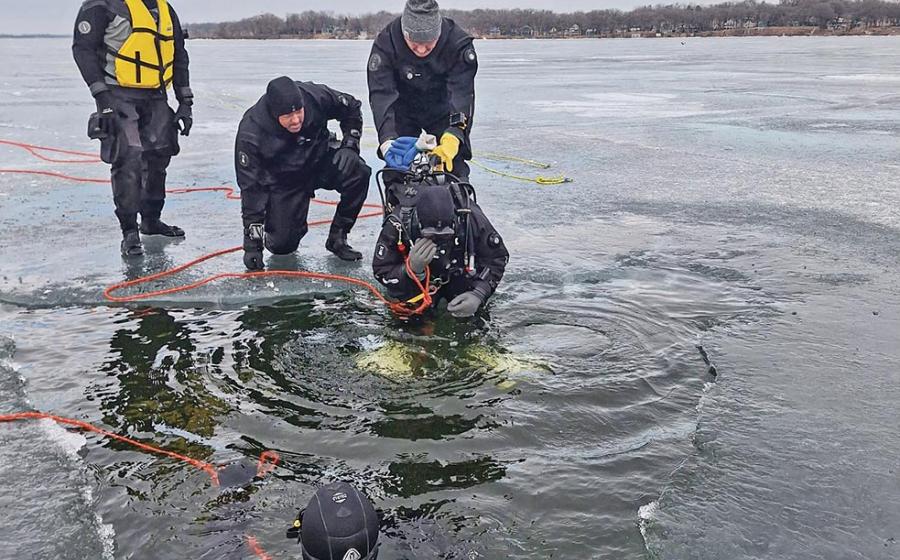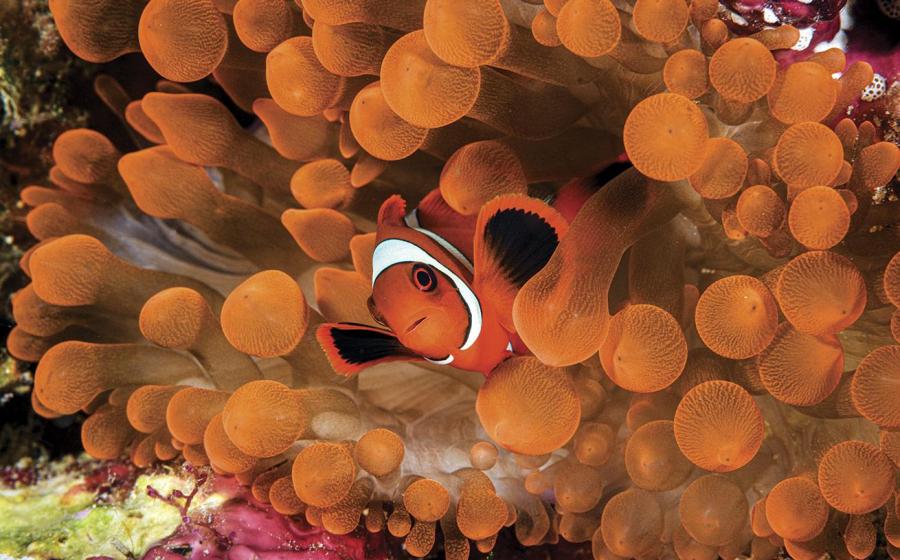Best Destinations for Healthy Marine Life

Brandon ColeA giant Pacific octopus tucks itself into a crevice. With a little luck, vigilant divers can spot one off the coast of British Columbia.
British Columbia
A favorite destination of Jacques Yves-Cousteau, British Columbia rules the list of cold-water dive destinations for its miles and miles of invertebrate life, from brightly colored sponges to the creepy-faced eels and massive octopuses that call it all home. Better still: This mix of life is nearly all dived from shore. Accessible, yes, but the cold water and currents complicate the dive plan for first-time visitors to the region. Hire a guide. Not only do newbies stay safe, but they’re more likely to see everything on their list. “It’s so easy to get all excited by everything you see and miss the wolf eel entirely because you don’t know where it is,” says Paul Wilburn, PADI Master Instructor with Rowand’s Reef Scuba Shop in Vancouver.
“We know where they are, and we can take you right to them,” he says. If the giant Pacific octopus tops someone’s must-see list, a good spot to try is Porteau Cove. A beginner dive area that’s home to four wrecks—three within recreational limits—it’s an ideal habitat for the ridiculously large octopuses. “There are tons of octopuses living in the wrecks all the time, and you’ll often see them free swimming,” says Chelsea Cunha, PADI Divemaster with Ocean Pro Divers in Surrey, just east of Vancouver.
Related Reading: Diving British Columbia's Panther Wreck
After someone has seen their share of eels and mollusks, it’s fun to geek out while hunting the small stuff. The greater Vancouver area is where low and slow wins the game. Much of the life, including a variety of sculpins—and the California scorpionfish, often called a sculpin—blend in expertly among the sponges and require a careful eye to notice. For some, these sponges, starfish and anemones are the biggest attraction, often for the sheer volume of acreage they occupy. “You’ll see starfish piled up all over the place,” says Cunha. Those who venture a bit deeper will also be treated to the sight of life overgrown to massive proportions. At 60 feet deep, the cloud sponges average just 2 feet across. Down around 100 feet, that same species swells in size to rival a car.
Need to Know Diving British Colombia
When to Go Year-round. Skip visiting in winter if the giant Pacific octopus tops your must-see list.
Water Temps 45 to 55 degrees.
Don’t Miss Whytecliff Park along Horseshoe Bay. “People go to see the cloud sponges, as we are one of the only areas left in the world that has them,” says Cunha. “They look like soft corals, but they’re hollow: Squat lobsters, sailfin sculpins and decorated warbonnets like to live inside.”
Contact Rowand’s Reef, Ocean Pro Divers

Mike HarterinkA seahorse latches itself securely to a coral branch in St. Eustatius.
St. Eustatius
The first thing to know about St. Eustatius—an 8-square-mile Caribbean isle 6 miles north of St. Kitts—is that the entire coastline, down to 90 feet, lies within a marine park. Second, this tiny gem’s leeward side supports a diversity of ecosystems, from muck dives to lava-formed canyons, rich with life. The Quill volcano stands as a hallmark in the south, appealing to hikers and birders alike. Below the waterline, this structure continues, with cracks widening to big, coral-covered ravines that divers can explore. “That seascape is otherworldly and amazing,” says Mike Harterink, owner of Scubaqua, a PADI IDC on the island. It’s also where divers will encounter pelagics, from eagle rays to hammerheads. Though not a true pelagic, Caribbean reef sharks also make regular appearances.
“Dive a week, and you’ll see a dozen,” says Harterink. “That tells you there is balance in our ecosystem.” Along the middle stretches of coast lie the muck dives, found amid historic wrecks. Here, the kaleidoscope of life varies from sailfin blennies to flying gurnards. To the north are the boulders—yet another unique setting. “Diversity is our unique selling point,” he says. “You can do five dives, and it feels like you’re diving five islands, each within a 10-minute boat ride from the shop.”
Need to Know Diving St. Eustatius
When to Go Year-round. Peak lobster spawning season is March through October.
Water Temps 79 to 82 degrees.
Don’t Miss The Chien Tong wreck at night. “The big papa and mama turtles go there to sleep, tucking under the staircase and other parts of the wreck so they don’t float up,” says Harterink. “It’s not rare to see a dozen table-size turtles.”
Contact Scubaqua Dive Center

Shutterstock/Valerijs NovickisManta ray spottings are common in the Galapagos Islands, where the gentle giants are often found riding the currents.
Galapagos Islands
If each big-animal dive destination were an act in a play, the Galapagos Islands of Ecuador would be the grand finale. “Every time I go somewhere else, everyone is excited when they see one big thing—like one giant manta,” says Jenny Waack, founder of Galapagos Shark Diving, which offers liveaboard trips alongside researchers. “In the Galapagos, you see so much all at once.” During prime season—June through November—that means one liveaboard trip puts divers face to face with warmer-water spectacles, including whale sharks and hammerheads, as well as cooler-water species, like orcas. The northernmost islands of Wolf and Darwin are hotspots for warm-water marine life, whereas the west coast of Isabela Island draws in cooler-water creatures.
Related Reading: The Best Scuba Destinations for Beginner Divers
This past year, up in the north, Waack’s groups encountered Eastern Tropical Pacific orcas that stayed for two weeks. Guests had the once-in-a-lifetime thrill of watching them hunt hammerheads. “The combinations that you see out there are just incredible,” she says. On a recent outing, her dive group idled in the water column as they came across a squadron of eagle rays. “They weren’t swimming, but just gliding, riding the current,” says Waack. “In the background, hammerheads were streaming by. You almost can’t see it all because there are so many animals all at once.” “If you love that kind of thing, there is no other place like it,” she says.
Need to Know Diving Galapagos
When to Go Galapagos Shark Diving targets the months of June through November for maximum encounters.
Water Temps The mix of currents ushers in waters cooler than the tropics. Be ready for 60to 75-degree water.
Don’t Miss Cape Douglas on Fernandina Island to be amused by marine iguanas. “People don’t know what to expect when they get in the water with the marine iguanas,” says Waack. “They’re not dangerous—they’re just very funny to watch as they feed.”
Contact Galapagos Shark Diving
Readers Choice Awards 2025
This year we surveyed 8,566 readers on their favorite destinations, resorts, operators and liveaboards, awarding their top picks across a variety of categories. Our Readers Choice travel feature highlights the first-place destinations in each global region and offers a taste of what makes each a reader favorite.
Click here to see all Readers Choice award-winning resorts, operators and liveaboards.










